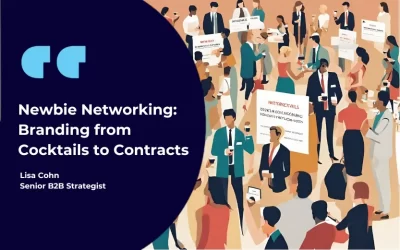Creating customer value is a key driver for both business survival and business growth. If we consider that the perception of value is often made up of a lot of variables like product quality, price, customer experience and competing alternatives, to name a few, it makes sense to understand what matters to customers. Customer centric B2B is table stakes, and for customers this is no longer optional. This makes putting the customer at the centre of your world not only important, but essential.
Commoditisation of technology solutions in the ICT industry seems to be a symptom of a sector that has not solved is customer centric B2B challenge yet. The difficulty in differentiating technologies stems from an innate focus on process and product first and the world of the buyer second.
This is why, at Demographica, our starting point is “outside-in” thinking. Start with an understanding of the world, the challenges, pain points and needs of customers and build solutions from there. Business anthropology is an effective tool, as it takes you physically into the world of your customer to get first-hand feedback.
Evidence of the effectiveness of a customer centric B2B approach is the positive results seen by B2B marketers that make use of account-based marketing (ABM) in their marketing mix. ABM is a strategic marketing approach jointly implemented by sales and marketing that focuses on key, targeted accounts. A key concern of ABM is to focus intensely on the reality of the customer, personalisation of engagements and customisation, and then adapts the business’s proposition to that. ABM delivers higher return on investment than other types of marketing, say 87% of companies, according to the Information Technology Services Marketing Association. Research firm SiriusDecisions has found that 80% say that ABM improves customer lifetime value. This is clear evidence that shows that customer-centricity pays.
The changing customer centric B2B journey
Access to technology and the internet has been a driving factor in changing the customer centric B2B journey. Customers have a huge choice in content on an almost unlimited number of platforms to learn and source information from. Digital natives, increasingly responsible for making purchase decisions, are also necessitating a re-evaluation of the customer journey. Their “B2C” digital behaviours carry over to the workplace and are forcing B2B organisations to change their approaches to these customers.
Economic and business challenges mean that a straightforward and linear nature of purchases by the decision-making unit is no longer the standard. As business priorities and budgets change, so too do the purchase journey and the related research to inform this decision. In essence this means that the purchase journey has changed from a linear funnel to more of a hurricane, with customers moving up and down a funnel as they need to.
This change in the customer centric B2B journey is not all positive, though. Forbes noted that the modern research and sales process is often more complicated than before and often leads to confusion, uncertainty and stress as a result of the sheer amount of content, business pressure and confusing sales processes.
What happens to organisations that don’t pay attention to this change? The simple answer is that they eventually pay for this oversight – in market share and revenue. A lack of attention on this front leads to a loss of relevance and favour with the customer, which can be detrimental in the long run, irrespective of the quality of solutions or products on offer.
The best tools to create a personalised and relevant customer journey
Since 2020 businesses have had more than 8,000 martech (marketing technology) solutions to choose from that can help personalisation efforts and create a relevant customer journey!
Below are five ways and tools businesses can use to approach their personalisation and customer journey efforts:
1. Website personalisation
Website personalisation provides the ability to personalise features on sites based on a visitor’s source or known data and to use artificial intelligence to provide content and product recommendations based on a visitor’s historical behaviours and interests. Personyze is a useful tool for website personalisation.
2. Marketing automation
Marketing automation provides the ability to deliver marketing e-mails based on a contact’s behaviour and interests, score contacts to determine when these should be handed to sales as opportunities, and use merge fields to customise and personalise the body copy of e-mails. HubSpot offers comprehensive marketing automation capabilities.
3. Customer-relationship management (CRM)
With a customer centric B2B approach, CRM provides the ability to track and store a prospects marketing and sales engagement to help inform and enable the sales teams’ engagement with prospects. HubSpot CRM and Salesforce are two tools for CRM.
4. Personality profiles
Generating personality profiles based on an individual’s online behaviour enables sales teams to have relevant and personalised conversations with their prospects. Crystal Knows offers extensive online personality profiling capabilities.
5. Intent engines
Intent engines monitor selected customers’ online searches and behaviour and alert a company when there is increased interest in a product or solution they sell. This offers a business an opportunity to approach a potential customer with a relevant solution when it matters. Bombora is an intent engine that offers this capability.
Common mistakes
The first mistake is treating customer understanding as a frivolous activity. Customer and customer centric B2B journey discovery and planning warrant focus and dedication and should not be approached as a lesser priority.
Another mistake is trying to be too sophisticated too quickly. There is merit in doing and getting the basics right first and building from there. Data and a complete, up-to-date database are of utmost importance as it is the foundation of all personalisation and customisation for customers. This is also, unfortunately, an element that is often overlooked in customer centric B2B approaches.
When it comes to customer experiences the death knell for an organisation comes when it does not make time to listen to customers but rely on their own perception/biases about them.
A 2018 Forbes article cited that 80% of companies believed that they offered customers a great experience, but when customers were asked, only 8% of them agreed. This says a lot about the work that still needs to be done on this front and offers a huge opportunity for ICT companies in SA.
This article, written by Stephan Erasmus, originally appeared on The Redzone.
Read our article here about how B2B customers are people too.



